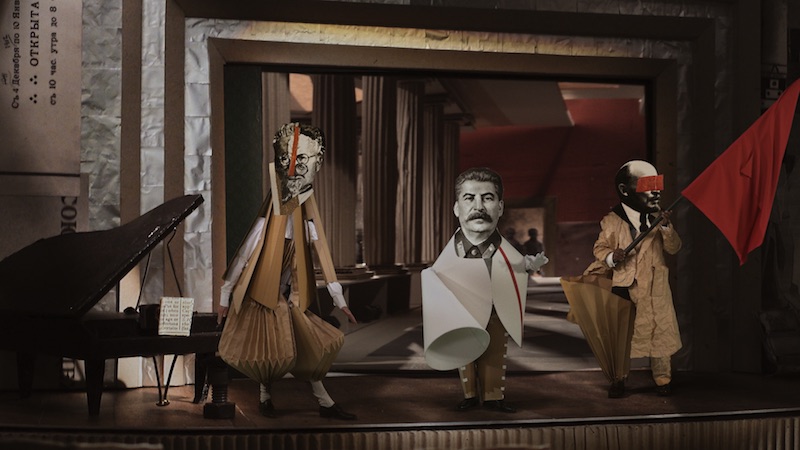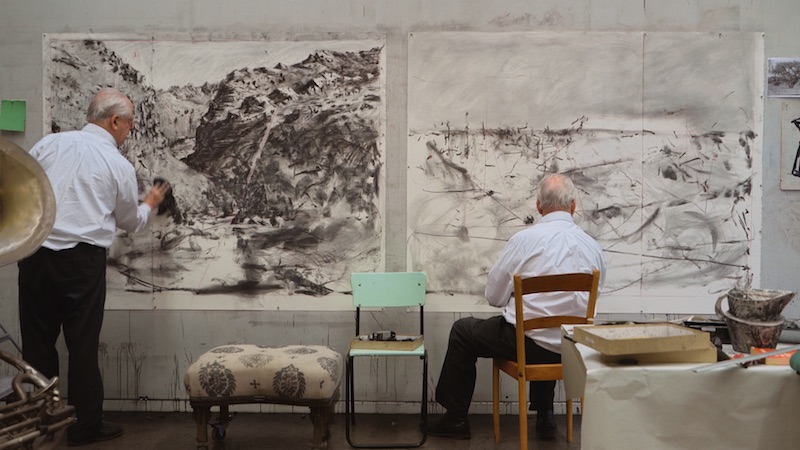by Dagmara Genda // Oct. 18, 2024
‘Self Portrait as a Pot of Coffee,’ a nine-part series by William Kentridge launching on MUBI on October 18th, is the result of a four-year project started during the first COVID lockdown in 2020. The roughly half-hour long videos owe their making to the isolation and generous swathes of time afforded to some artists by the pandemic. The isolation is most pronounced in the first few episodes, where Kentridge inhabits his studio with his double. Sometimes he stands beside himself, at other times eyes his counterpart from across the table, or they busy themselves with tasks in different corners of the space. More often than not, they disagree. One represents the analytical sceptic while the other is an expert at what Kentridge in the first episode calls “peripheral thinking,” which is the allowance of thoughts to emerge at the edge of one’s headspace.
The studio—which the series documents, questions, animates and pushes into impossible flights of fancy, like when objects come alive at night and animations bleed into filmed reality—is presented as a type of external brain that, like the internal one, mulls over the poles of possibility and inevitability. With each step in the process, emerges “Torschlusspanik,” which is the fear that each decision closes a door to another possible outcome. The inevitable end, for Kentridge, is symbolised by the coffee pot. It’s everyday banality represents the finality of a process that promised so many directions, but ended in just one. When one reaches this inevitable end, notes Kentridge, one looks back and thinks, “Now I understand what the project should have been. Now I am ready to begin.”
DG: Uncertainty, instability and doubt play a recurring role in the episodes: doubt in art, uncertainty in images and language, etc. Has the nature and scale of this doubt and uncertainty changed for you over time?
William Kentridge: Over the years, I’ve realised that most of the interesting things that have appeared in my art—or what was of interest to viewers I should say—have not been things I’ve planned, but things that other people have recognised and things that I’ve later come to recognise myself. All the clear good ideas I think I’ve had, have always been much more shaky, which is why I started the Centre for the Less Good Idea in Johannesburg. In the art making process, the category of recognition is more important than the category of knowing. To recognise something as it emerges rather than knowing it in advance is how it should be.
All claims to certainty have in them either a wish fulfillment or else a recourse to violence that insists on them. So, the idea of starting without a script or storyboard, as this series was done, was to trust that there are things inside ourselves that we know, but that we may not know that we know, that will emerge in the process.

Still from ‘Self-Portrait as a Coffee Pot,’ Episode 1: ‘A Natural History of the Studio,’ 2022, HD Video, 22 min 03 sec // Courtesy William Kentridge Studio
DG: Though you have never called yourself a political artist, the history of apartheid in South Africa, as well as resistance to it, plays a large role in your family history as well as your work. Do the politics of today play an equally important role in your practice?
WK: The volatile politics of today are present in the studio in the sense that what one reads every day on the phone, in the papers and sees on television shows make their way inside in unpredictable ways. So it’s not as if the news of the war in Sudan, for example, in which huge numbers of people are dying, but it remains invisible in the mainstream news, means I need to do work about what is happening in Sudan. But a theatre work like ‘The Great Yes, The Great No’ (2024), which is ostensibly about a journey across the Atlantic during the Second World War, is about current questions and conditions of migration, of how one might define identity between different places or different points of origin. So yes, the politics of the world and elements of the political come into the studio, and percolate and come out in one form or another.

Still from ‘Self-Portrait as a Coffee Pot,’ Episode 8: ‘Oh To Believe in Another World,’ 2022, HD Video, 31 min 23 sec // Courtesy William Kentridge Studio
DG: The film project, ‘Oh To Believe in Another World’ (2022), the making of which is documented in Episode 8, stands out as an aesthetically and thematically divergent element in your oeuvre. I think of El Lissitsky and Hannah Darboven when I look at the movements, the lines and collage aesthetic in the work. How does your process for that work compare to your more recognisable, gestural approach with charcoal and ink?
WK: In all of the projects I do, there always has to be a meeting between something outside in the world that is bigger than the studio, and some material in the studio, which is used to think through the question. In this case, it was the question of artists and power, of Shostakovich in the Soviet Union, of Mayakovsky shifting from great enthusiasm for the revolution to shooting himself 12 years later. There was something about the cardboard world we were making for the film for the Shostakovich symphony that called for collage. I made some drawings for masks for the characters, but as we filmed and looked at them, a more photographic language spoke better to the music and themes we were following.
I suppose after the event one could do an analysis of what sort of themes the charcoal animations seem to work for. Is it about personal memories? Or about the difficulty of keeping track of time? I sometimes think the gestural work in the drawing is also a kind of gestural work that happens in practice: what is the tension in the body? Where does the gesture originate from in the shift from a singer, to an actor, to a dancer?

Still from ‘Self-Portrait as a Coffee Pot,’ Episode 2: ‘Self Portrait as a Coffee Pot,’ 2022, HD Video, 33 min 15 sec // Courtesy William Kentridge Studio
DG: On a more specific note, I am curious about all the books on which you make drawings and paintings. What role does this not-blank page play for you and does it matter what is written on the pages? Where do you find these books?
WK: The books are usually old reference works, dictionaries or encyclopedias. There is something about the received wisdom of old knowledge, which is really inscribed, which is redrawn. But there is also the practical question of the printed page, both from having a grid on it, like the geometric grid of the columns, but also the particular qualities of the different papers. Some dictionaries have shiny paper, some have more tooth, or books printed before 1830 have different qualities. With a book, you start not with a white sheet, but something which already has a greyness to it. This means you can build up darker tones or add lighter ones with the light pastel.
Sometimes I will start drawing on plain sheets of paper, but quite often the drawings will shift into hunting through books I find in second hand bookstores, to find the right format, the right paper, the right quality, the right texture. It’s still hard to find old cash books. Interior decorators buy old cash books to decorate accountants offices, to give them some kind of warmth. So sometimes I have to fight with interior decorators to get a hold of the old cash books that are fantastic to draw on.

Still from ‘Self-Portrait as a Coffee Pot,’ Episode 3: ‘Vanishing Points,’ 2022, HD Video, 34 min 19 sec // Courtesy William Kentridge Studio
DG: An image from the series that stayed with me comes from the end of Episode 3 where the art gallery in Johannesburg dissolves into black smudges. This gallery, as you explained in the video, was one of the contradictions of colonialism. I am curious if you have a vision or hope for art outside the gallery and museum system?
WK: The Johannesburg Art Gallery was the gallery of my childhood, what I thought all art galleries were. It was designed by the great English architect, Edward Lutyens, and had very generous spaces filled with traditional European paintings, drawings and sculptures. It has since fallen into disuse. Physically, it has all but collapsed. Most of the collection is on loan to other institutions, large portions of it have been stolen and the institution just hobbles along. It’s, on the one hand, a grief that this gallery of my childhood is collapsing and hardly exists. On the other hand, it also says: “what is the strange nature of these European paintings and Dutch lace? How do they fit into a contemporary cosmopolitan city in Africa?” The question of the gallery and its precariousness echoes in the broader questions of where we are and who we are in the city.



















